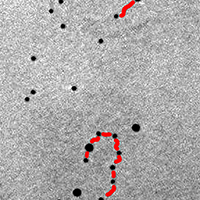Ultrastructural immunocytochemistry shows impairment of RNA pathways in skeletal muscle nuclei of old mice: A link to sarcopenia?

Submitted: 15 February 2021
Accepted: 15 March 2021
Published: 24 March 2021
Accepted: 15 March 2021
Abstract Views: 1125
PDF: 532
HTML: 10
HTML: 10
Publisher's note
All claims expressed in this article are solely those of the authors and do not necessarily represent those of their affiliated organizations, or those of the publisher, the editors and the reviewers. Any product that may be evaluated in this article or claim that may be made by its manufacturer is not guaranteed or endorsed by the publisher.
All claims expressed in this article are solely those of the authors and do not necessarily represent those of their affiliated organizations, or those of the publisher, the editors and the reviewers. Any product that may be evaluated in this article or claim that may be made by its manufacturer is not guaranteed or endorsed by the publisher.
Similar Articles
- Jianyu Zou, Zhenbin Cai, Zhi Liang , Yaozhong Liang, Guowei Zhang, Jie Yang, Yunlong Zhang, Hongsheng Lin, Minghui Tan, Different fusion tags affect the activity of ubiquitin overexpression on spastin protein stability , European Journal of Histochemistry: Vol. 65 No. 4 (2021)
- Xiaoyan Chu, Jun Lou, Yun Yi, Linlin Zhong, Ouping Huang, Knockdown of ARHGAP30 inhibits ovarian cancer cell proliferation, migration, and invasiveness by suppressing the PI3K/AKT/mTOR signaling pathway , European Journal of Histochemistry: Vol. 67 No. 2 (2023)
- Carolina Pellegrini, Vanessa D'Antongiovanni, Chiara Ippolito, Cristina Segnani, Luca Antonioli, Matteo Fornai, Nunzia Bernardini, From the intestinal mucosal barrier to the enteric neuromuscular compartment: an integrated overview on the morphological changes in Parkinson’s disease , European Journal of Histochemistry: Vol. 65 No. s1 (2021): Special Collection on Advances in Neuromorphology in Health and Disease
- T. Karaca, Y. Hulya Uz, R. Karabacak, I. Karaboga, S. Demirtas, A. Cagatay Cicek, Effects of hyperthyroidism on expression of vascular endothelial growth factor (VEGF) and apoptosis in fetal adrenal glands , European Journal of Histochemistry: Vol. 59 No. 4 (2015)
- C. Loreto, L. E. Almeida, M.R. Migliore, M. Caltabiano, R. Leonardi, TRAIL, DR5 and caspase 3-dependent apoptosis in vessels of diseased human temporomandibular joint disc. An immunohistochemical study , European Journal of Histochemistry: Vol. 54 No. 3 (2010)
- Tao Wu, Shikui Wu, Hailu Jiao, Jun Feng, Xiang Zeng, Overexpression of hsa_circ_0001861 inhibits pulmonary fibrosis through targeting miR-296-5p/BCL-2 binding component 3 axis , European Journal of Histochemistry: Vol. 67 No. 4 (2023)
- T. Lorenzi, A. Turi, C. Crescimanno, M. Morroni, M. Castellucci, G. David, A. L. Tranquilli, D. Marzioni, Syndecan expressions in the human amnion and chorionic plate , European Journal of Histochemistry: Vol. 54 No. 4 (2010)
- I. N. Vatsos, Y. Kotzamanis, M. Henry, P. Angelidis, M. Alexis, Monitoring stress in fish by applying image analysis to their skin mucous cells , European Journal of Histochemistry: Vol. 54 No. 2 (2010)
- Y. Liu, J. Weng, S. Huang, Y. Shen, X. Sheng, Y. Han, M. Xu, Q. Weng, Immunoreactivities of PPARγ2, leptin and leptin receptor in oviduct of Chinese brown frog during breeding period and pre-hibernation , European Journal of Histochemistry: Vol. 58 No. 3 (2014)
- Giovanni Li Volti, The Chaperonopathies - Diseases with Defective Molecular Chaperones , European Journal of Histochemistry: Vol. 57 No. 4 (2013)
<< < 27 28 29 30 31 32 33 34 35 36 > >>
You may also start an advanced similarity search for this article.

 https://doi.org/10.4081/ejh.2021.3229
https://doi.org/10.4081/ejh.2021.3229










